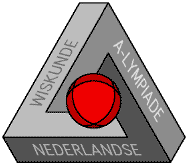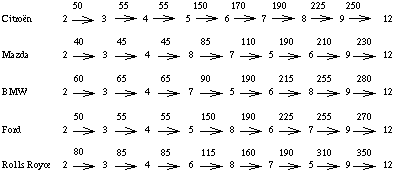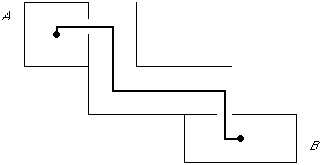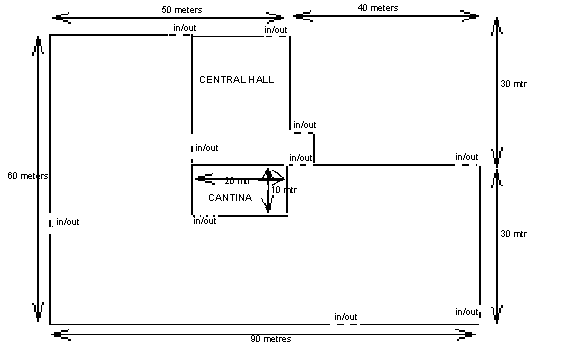 Math A-lympiad: Preliminary
1994-1995
Math A-lympiad: Preliminary
1994-1995 Math A-lympiad: Preliminary
1994-1995
Math A-lympiad: Preliminary
1994-1995Small Car Inc. is a producer of scale model cars. The company produces a number
of models on a 1 : 2 scale.
The models are made as faithfully as possible to the original construction,
complete with engine. The cars are exported to Japan, the United States, Arab
countries, Canada, Australia and a few western European countries. Customers
mainly use the cars for promotional purposes, for example in showrooms and at
exhibitions.
Around a hundred people work at Small Car Inc. spread over a number of different
departments.
The following models are produced:
-CitroŽn Xantia,
- Mazda 323F,
- BMW 520,
- Ford Mondeo,
- Rolls Royce Silver Shadow.
The production schedule has been chosen for an optimum distribution of production between the departments. According to this schedule, which is not considered in the assignment, 5 CitroŽns, 7 Mazdas, 10 BMWs, 8 Fords and 2 Rolls Royces are worked on each day in each department.
There are twelve departments in the company:
| 1 | Stores | 180 m2 |
| 2 | Sheet metal stamping | 250 m2 |
| 3 | Bodywork | 400 m2 |
| 4 | Spray shop | 100 m2 |
| 5 | Engines | 300 m2 |
| 6 | Dashboard | 150 m2 |
| 7 | Seats | 250 m2 |
| 8 | Wheels | 180 m2 |
| 9 | Finishing | 300 m2 |
| 10 | Canteen | 200 m2 |
| 11 | Office | 100 m2 |
| 12 | Central hall | 600 m2 |
The production process for each model begins with stamping the sheet metal
and then welding it together, and then assembling this sheet metal in the bodywork
department. After that, the bodywork is sprayed in the spray shop. For production-technical
reasons the models go through the other departments in different orders depending
on the make. The production process always ends with the finishing department
however. Models that are ready are parked in the central hall until delivery
to the customer.
The canteen and office departments are support departments and are not directly
involved in the production process of course.
The various departments are described further in appendix A.
The cars in production must be regularly transported from one department to the next. The order of the departments is specified below. From this schedule one can also see how heavy a model is during transport from one department to the next.
 |
The production of a CitroŽn Xantia begins with the stamping of the sheet metal. The 50kg sheet metal is transported to the bodywork department and assembled together there. The aim is to use the sheet metal as efficiently as possible. The residual waste can thus be neglected in this exercise. The 55kg body is then transported to the spray shop and sprayed (the weight increase here is negligible). Then the engine is fitted in the engines department after which the car weighs 150kg. The dashboard is fitted after that. It all then weighs 170kg. With the seats added the Xantia weighs 190kg, and with wheels 225kg. Finally the completed model weighs 250kg.
A model in production is made heavier through the addition of components in (almost) every department. These components are transported in the morning in the right quantities from the stores.
The transport of a model in production from one department to the next is by
special transport trolleys. There are two types of trolley in use: a light version
for models up to 100kg and a heavy version for the heavier models.
Transport with the light trolleys costs É1 per meter per model and with the
heavy trolleys É2 per meter per model. A model fitted with wheels is easier
to transport: it costs É0.50 per meter.
The transport of the necessary materials and components to the departments is
done in the mornings in the quantities needed for one day of production. This
is done in boxes that can contain a maximum of 150kg. The transport of these
boxes costs É 0.75 per box per meter.
example 1:
The transport of a CitroŽn from department 2 to department 3 costs one guilder per meter.example 2:
The transport of a CitroŽn from department 5 to department 6 costs two guilders per meter.example 3:
The transport of a Mazda which goes from department 5 to department 6 costs É 0.50 per meter, as this Mazda already has wheels.example 4:
35kg of materials and components have to be transported to department 8 in the morning for each CitroŽn.
Exercise 1
The transport costs will depend on the distances between departments. For each
pair of departments calculate the total transport costs per meter per day. The
distance between departments is still left out of consideration here. (You can
set out this information in a table or matrix for example with the departments
given horizontally and vertically).
Management recently purchased new factory premises in an industrial estate. They had to do so because the local council required them to relocate from the inner city, due to the increasing nuisance caused to residents in the inner city. The premises that management purchased are big enough for housing the production facilities (see appendix B). There is already a nice, centrally located canteen in the premises. There is also a central hall for the storage of finished models. Management is now ready to allocate a position for each of the departments in the new premises. The principle here is that the costs of transport between departments must be as low as possible.
The following conditions must also be satisfied:
- The pathways for transport between departments must be at least 5 meters wide.
- Every department must be at least 10 meters wide, except for the spray shop, which must be at least 5 meters wide.
- The stores must be located by an entrance/exit to the outside for deliveries from outside.
- All other entrances/exits to the outside must be located on a pathway.
- The canteen must remain in its existing position.
- For safety reasons, the spray shop must be located on an outside wall and may not be located directly next to other departments (at least 1 meter of clearance).
- Every department has an entrance/exit 5 meters wide. All transport is between these entrances/exits.
They would also like to satisfy the following conditions:
-The departments must be rectangular if possible.
- The pathways must have as few corners as possible.
- The office must be close to the canteen.
- With regard to safety requirements, both entrances/exits from the central hall to the factory must be kept clear (so no department may be placed in front of it).
The distance between two departments is measured as follows:
 |
From the middle of the one department to the middle of the pathway via the entrance/exit using a path with right angled corners. Then from the middle of the pathway to the entrance/exit of the other department and then again to the middle of this department. (See drawing)
Exercise 2
